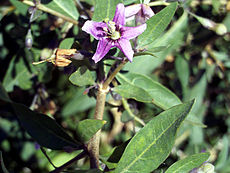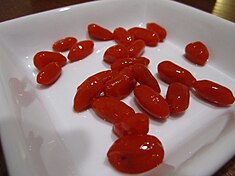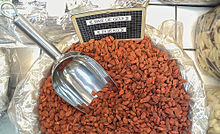Goji

Goji, goji berry or wolfberry is the fruit of Lycium barbarum (Chinese: 寧夏枸杞 pinyin: níngxià gǒuqǐ) and Lycium chinense (Chinese: 枸杞 pinyin: gǒuqǐ), two closely related species of boxthorn in the family Solanaceae. The family also includes the potato, tomato, eggplant, deadly nightshade, chili pepper, and tobacco. The two species are native to Asia.[1]
Description
Wolfberry species are deciduous woody perennial plants, growing 1–3 m high. L. chinense is grown in the south of China and tends to be somewhat shorter, while L. barbarum is grown in the north, primarily in the Ningxia Hui Autonomous Region, and tends to be somewhat taller.
Leaves and flowers


Wolfberry leaves form on the shoot either in an alternating arrangement or in bundles of up to three, each having either a lanceolate (shaped like a spearhead longer than it is wide) or ovate (egg-like) shape. Leaf dimensions are 7.0 cm wide by 3.5 cm broad with blunted or rounded tips.
The flowers grow in groups of one to three in the leaf axils. The calyx (eventually ruptured by the growing berry) consists of bell-shaped or tubular sepals forming short, triangular lobes. The corollae are lavender or light purple, 9–14 mm wide with five or six lobes shorter than the tube. The stamens are structured with filaments longer than the anthers. The anthers are longitudinally dehiscent.
In the Northern Hemisphere, flowering occurs from June through September and berry maturation from August to October, depending on the latitude, altitude, and climate.
Fruit
These species produce a bright orange-red, ellipsoid berry 1–2 cm in diameter. The number of seeds in each berry varies widely based on cultivar and fruit size, containing 10–60 tiny yellow seeds that are compressed with a curved embryo. The berries ripen from July to October in the Northern Hemisphere.
Etymology
Lycium, the genus name, is derived from the ancient southern Anatolian region of Lycia (Λυκία).[2] The fruit is known in pharmacological references as Lycii fructus, which is Latin for "Lycium fruit".
"Wolfberry", a commonly used English name,[3] has unknown origin, perhaps resulting from the Mandarin root, gou, meaning wolf [dubious – discuss] [4] or confusion over the genus name, Lycium, which resembles lycos, the Greek word for wolf.
In the English-speaking world, the name "goji berry" has been used since the early 21st century.[5] The word "goji" is an approximation of the pronunciation of gǒuqǐ, the name for L. chinense in several Chinese dialects,[4] including Hokkien and Shanghainese. This name possibly derives from the same roots as the Persian language term gojeh which means "plum/berry".[citation needed]
Significance
Since the early 21st century, interest has increased for wolfberries for their novelty and nutrient value.[4][6] They have been termed a superfruit, which has led to a profusion of consumer products.[7][8][9] In traditional medicine, the whole fruit or its extracts have numerous implied health effects [which?] which remain scientifically unconfirmed as of 2014.[4][5]
Cultivation
China
The majority of commercially produced wolfberries come from the Ningxia Hui Autonomous Region of north-central China and the Xinjiang Uyghur Autonomous Region of western China, where they are grown on plantations totaling 200,000 acres.[9] In Zhongning County, Ningxia, wolfberry plantations typically range between 40 and 400 hectares (100–1000 acres or 500–6000 mu) in area. As of 2005, over 10 million mu have been planted with wolfberries in Ningxia.
Cultivated along the fertile aggradational floodplains of the Yellow River for more than 700 years, Ningxia wolfberries have earned a reputation throughout Asia for premium quality sometimes described commercially as "red diamonds".[10] Government releases of annual wolfberry production, premium fruit grades, and export are based on yields from Ningxia, the region recognized with
- The largest annual harvest in China, accounting for 39% (13 million kg, 2001) of the nation's total yield of wolfberries, estimated at approximately 33 million kg (72 million lb) in 2001
- Formation of an industrial association of growers, processors, marketers, and scholars of wolfberry cultivation to promote the berry's commercial and export potential
- The nation's only source of therapeutic grade ("superior-grade") wolfberries used by practitioners of traditional Chinese medicine[11]
In addition, commercial volumes of wolfberries grow in the Chinese regions of Inner Mongolia, Qinghai, Gansu, Shaanxi, Shanxi, and Hebei. When ripe, the oblong, red berries[9] are tender and must be picked carefully or shaken from the vine into trays to avoid spoiling. The fruits are preserved by drying them in full sun on open trays or by mechanical dehydration employing a progressively increasing series of heat exposure over 48 hours.
Wolfberries are celebrated each August in Ningxia with an annual festival coinciding with the berry harvest. Originally held in Ningxia's capital, Yinchuan, the festival has been based since 2000 in Zhongning County, an important center of wolfberry cultivation for the region. As Ningxia's borders merge with three deserts, wolfberries are also planted to control erosion and reclaim irrigable soils from desertification.[12]
China, the main supplier of wolfberry products in the world, had total exports generating US$120 million in 2004. This production derived from 82,000 ha farmed nationwide, yielding 95,000 tons of wolfberries,[10] which has increased from larger acreages cultivated in recent years.[9]
Pesticide and fungicide use
Organochlorine pesticides are conventionally used in commercial wolfberry cultivation to mitigate destruction of the delicate berries by insects. Since the early 21st century, high levels of insecticide residues (including fenvalerate, cypermethrin, and acetamiprid) and fungicide residues (such as triadimenol and isoprothiolane), have been detected by the United States Food and Drug Administration in some imported wolfberries and wolfberry products of Chinese origin, leading to the seizure of these products.[13]
China's Green Food Standard, administered by the Chinese Ministry of Agriculture's China Green Food Development Center, does permit some pesticide and herbicide use.[14][15][16]
United Kingdom
On June 18, 2007, the UK Food Standards Agency stated a significant history exists of the fruit being consumed in Europe before 1997, and has removed it from the Novel Foods list.[17] It is now legal to sell the wolfberry in the UK as a food as reported by the Food Standards Agency,[18] though with concerns over marketing claims over potential health benefits.
Importation of mature plants
Importation of wolfberry plants into the United Kingdom from most countries outside Europe is illegal, due to the possibility they could be vectors of diseases attacking Solanaceae crops, such as potato or tomato.[19]
Canada and United States
During the first decade of the 21st century, farmers in Canada and the United States began cultivating goji on a commercial scale to meet potential markets for fresh berries, juice, and processed products.[20][21]
Uses
Wolfberries are usually sold in open boxes and small packages in dried form.

Culinary
As a food, dried wolfberries are traditionally cooked before consumption. Dried wolfberries are often added to rice congee and almond jelly, as well as used in Chinese tonic soups, in combination with chicken or pork, vegetables, and other herbs such as wild yam, Astragalus membranaceus, Codonopsis pilosula, and licorice root.[citation needed] The berries are also boiled as a herbal tea, often along with chrysanthemum flowers and/or red jujubes, or with tea, and packaged teas are also available.[citation needed]
Various wines containing wolfberries (called gǒuqǐ jiǔ) are also produced, including some that are a blend of grape wine and wolfberries.[citation needed]
Young wolfberry shoots and leaves are also harvested commercially as a leaf vegetable.[22][23]
Medical research
Goji is the subject of research to determine if it has any useful medicinal properties; although it is not toxic, a lack of clinical evidence and poor quality control in the manufacture of Goji products means it cannot currently be recommended for medicinal use.[24]
Safety issues
Two published case reports described elderly women who experienced increased bleeding, expressed as an elevated INR, after drinking quantities of wolfberry tisane.[25][26] Further in vitro testing revealed that the tea inhibited warfarin metabolism, providing evidence for possible interaction between warfarin and undefined wolfberry phytochemicals.[5][25]
Atropine, a toxic alkaloid found in other members of the Solanaceae family, occurs naturally in wolfberry fruit. The atropine concentrations of berries from China and Thailand was tested and found to be variable, with a maximum content of 19 ppb, well below a toxic level.[27] However, misidentified or adulterated samples with higher atropine levels may explain earlier, much higher, measurements.[27]
Potentially harmful interactions may occur if wolfberry is consumed while taking other medications, such as those metabolised by the cytochrome P450 liver enzymes.[5] Such drugs include warfarin, or drugs for diabetes or hypertension.[5]
Marketing

Since the early 21st century, the dried fruit has been marketed in the West as a health food, often accompanied by scientifically unsupported claims regarding its purported health benefits.[6] The level of vitamin C is comparable to many citrus fruits and strawberries.[28]
Companies marketing the berries often propagate the unsupported myth that a Chinese man named Li Qing Yuen, who was said to have consumed wolfberries daily, lived to the age of 256 years (1677–1933).
Commercial products marketed outside Asia
The presence of wolfberry in health food stores and grocery markets is increasing in the United Kingdom and other countries.[29]

Other wolfberry consumer applications include:
- Dried berries (pictured above)
- Berry pieces in granola bars[30]
- Yogurt products
Commercial suppliers have processed wolfberry as
- An additive for manufacturing
- Juice concentrate
- Whole fruit purée
- Pulp powders
- Whole or ground seeds
Marketing claims under scrutiny in Europe
In February 2007, the Food Standards Agency (FSA) of the United Kingdom, an advisor for food safety to the European Food Safety Authority of the European Union (EU), published an inquiry to retailers and health food stores requesting evidence of significant use of wolfberries in Europe before 1997.[31] Information from this period would document a safety history and evaluate how "novel" the berries are in the EU, affecting their authorization status for sale.[29]
Proponents hoped this review would provide important safeguards for consumers by checking whether new foods are suitable for the whole population, including people with food allergies. Opponents, though, feared it would limit consumer choice and protect monopolistic interests rather than the public.[32] Food safety in the EU relies importantly on a scientific basis for label information on foods like wolfberries that may be claimed to furnish health benefits.[33]
In June 2007, the FSA announced its decision that wolfberries indeed had a history of use in Great Britain before 1997.[29][34] Accordingly, wolfberries do not require registration as a novel food.
Marketing claims under scrutiny in Canada and the United States
In January 2007, marketing statements for a goji juice product were subject of an investigative report by CBC Television's consumer advocacy program Marketplace.[35]
By one specific example in the CBC interview, Earl Mindell (then working for direct-marketing company FreeLife International, Inc.) falsely claimed the Memorial Sloan-Kettering Cancer Center in New York had completed clinical studies showing that use of wolfberry juice would prevent 75% of human breast cancer cases.
During 2006, the U.S. Food and Drug Administration (FDA) placed two goji juice distributors on notice with warning letters about marketing claims.[36][37] These statements were in violation of the United States Food, Drug and Cosmetic Act [21 USC/321 (g)(1)][38] because they "establish the product as a drug intended for use in the cure, mitigation, treatment, or prevention of disease" when wolfberries or juice have had no such scientific evaluation. Additionally stated by the FDA, the goji juice was "not generally recognized as safe and effective for the referenced conditions" and therefore must be treated as a "new drug" under Section 21(p) of the Act. New drugs may not be legally marketed in the United States without prior approval of the FDA.
On May 29, 2009, a class action lawsuit was filed against FreeLife in the United States District Court of Arizona. This lawsuit alleges false claims, misrepresentations, false and deceptive advertising and other issues regarding FreeLife’s Himalayan Goji Juice, GoChi, and TaiSlim products. This lawsuit seeks remedies for consumers who have purchased these products over the past several years.[39][40]
See also
- Gouqi jiu
- List of culinary fruits
- List of dried foods
- Sea buckthorn – another plant that somewhat resembles Wolfberry
References
- ^ Flint, Harrison Leigh (1997). "Lycium barbarum". Landscape plants for eastern North America: exclusive of Florida and the immediate Gulf Coast. Chichester: John Wiley & Sons. p. 326. ISBN 978-0-471-59919-7.
{{cite book}}: External link in|chapterurl=|chapterurl=ignored (|chapter-url=suggested) (help) - ^ Huxley, A., ed. (1992). New RHS Dictionary of Gardening. Macmillan ISBN 0-333-47494-5.
- ^ "Scientific classification for Lycium barbarum L." Natural Resources Conservation Service. US Department of Agriculture. Retrieved 13 April 2013.
- ^ a b c d Dharmananda S (2007). "Lycium fruit: food and medicine". Institute for Traditional Medicine.
- ^ a b c d e "Lycium". MedlinePlus. US National Institutes of Health. January 2013. Retrieved 13 April 2013.
- ^ a b Gross PM (2007). "Goji: what it is... and isn't". Engredea NewHope 360.
- ^ McNally A. Superfoods market set to double by 2011, NutraIngredients.com-Europe, October 8, 2007
- ^ Runestad T. Functional Ingredients market overview, Functional Ingredients, October 2007
- ^ a b c d Fouch S, Hanson E. "Potential for saskatoon and goji berry production in the Great Lakes region" (PDF). Michigan State University. Retrieved 9 March 2014.
- ^ a b "Wolfberry festival to be held in Ningxia". China Daily. July 19, 2004. Retrieved 2015-02-05.
- ^ "China's first provincial-level wolfberry association established". People's Daily. August 19, 2001. Retrieved 2015-02-05.
- ^ Liu, Yunyun (October 11, 2008). "Dry no more". Beijing Review. Retrieved 2015-02-05.
- ^ IA #99-08, Revision to Import Alert #99-08, "Detention Without Physical Examination of Processed Products for Pesticides"
- ^ Pathbreaking Newsletter Promotes Development of Organic Sector in China Lila Buckley. Worldwatch Institute. 28 February 2006.
- ^ GAIN Report #CH1072. Dueling Standards for Organic Foods 2001 Ralph Bean and Xiang Qing. USDA Global Agriculture Information Network Foreign Agricultural Service. 12 Dec 2001.
- ^ The Movement Toward Organic Herb Cultivation in China Subhuti Dharmananda. Institute for Traditional Medicine. January 2004.
- ^ The Novel Foods and Novel Food Ingredients Regulations 1997
- ^ Food Standards Agency, June 2007, Responses on goji berries reviewed
- ^ Department for Environment, Food and Rural Affairs, April, 2008. Prohibited Import of Goji Plants. April 30, 2008
- ^ Boutin, N (July 30, 2008). "Fairground family first to gamble on gojis". Woodstock Sentinel Review. Sun Media. Retrieved 14 April 2013.
- ^ Karp, D (August 5, 2009). "Goji taunts North American farmers". Los Angeles Times - Food. LA Times. Retrieved 14 April 2013.
- ^ Isabelle, M.; Lee, B.L.; Lim, M.T.; Koh, W.-P.; Huang, D.; Ong, C.N. (2010). "Antioxidant activity and profiles of common vegetables in Singapore". Food Chemistry. 120 (4): 993–1003. doi:10.1016/j.foodchem.2009.11.038.
{{cite journal}}: CS1 maint: multiple names: authors list (link) - ^ Dong, J.; Lu, D.; Wang, Y. (2009). "Analysis of flavonoids from leaves of cultivated Lycium barbarum L." Plant Foods for Human Nutrition. 64 (3): 199–204. doi:10.1007/s11130-009-0128-x.
{{cite journal}}: CS1 maint: multiple names: authors list (link) - ^ Potterat O (January 2010). "Goji (Lycium barbarum and L. chinense): Phytochemistry, pharmacology and safety in the perspective of traditional uses and recent popularity". Planta Med. 76 (1): 7–19. doi:10.1055/s-0029-1186218. PMID 19844860.
- ^ a b Lam AY, Elmer GW, Mohutsky MA (October 2001). "Possible interaction between warfarin and Lycium barbarum L". Ann Pharmacother. 35 (10): 1199–201. doi:10.1345/aph.1Z442. PMID 11675844.
{{cite journal}}: CS1 maint: multiple names: authors list (link) - ^ Leung H, Hung A, Hui AC, Chan TY (May 2008). "Warfarin overdose due to the possible effects of Lycium barbarum L.". Food Chem. Toxicol. 46 (5): 1860–2. doi:10.1016/j.fct.2008.01.008. PMID 18281140.
{{cite journal}}: CS1 maint: multiple names: authors list (link) - ^ a b Adams, M; Wiedenmann, M; Tittel, G; Bauer, R. (September 2006). "HPLC-MS trace analysis of atropine in Lycium barbarum berries". Phytochem Anal. 17 (5): 279–83. doi:10.1002/pca.915. PMID 17019928.
{{cite journal}}: CS1 maint: multiple names: authors list (link) - ^ Linus Pauling Institute, Micronutrient Information Center
- ^ a b c "Goji Berries" (PDF). UK Food Standards Agency, Novel Foods, Additives and Supplements Division. June 2007. Retrieved 13 April 2013.
- ^ Baltazar A (January 2010). "Raising the Bar (on Chocolate)". Nutraceuticals World. Rodman Media. Retrieved 13 April 2013.
- ^ Agency seeks evidence of goji berry consumption, UK Food Standards Agency, February 2007
- ^ 'Miracle' goji berries face ban under EU red tape, The Daily Mail, February 2007
- ^ Nutrition and health claims, European Food Safety Authority, May 2007
- ^ Responses on goji berries reviewed, UK Food Standards Agency, June 2007
- ^ CBC News http://www.cbc.ca/marketplace/2007/01/goji.html.
{{cite news}}: Missing or empty|title=(help); Unknown parameter|deadurl=ignored (|url-status=suggested) (help) [dead link] - ^ US FDA Letter to Dynamic Health Laboratories, Inc.
- ^ US FDA, Letter to Healthsuperstore.com
- ^ "Federal Food, Drug, and Cosmetic Act (FD&C Act)".
- ^ United States District Court for the District of Arizona (May 29, 2009). "Class action lawsuit against FreeLife International, Inc" (PDF). Retrieved 2009-10-31.
- ^ Class-Action Suit Filed against FreeLife and Earl Mindel
Further reading
- Books
- Oyama, Sumita (1964). Kuko o Aishite Junen (Lycium chinense in Favorable Use for Ten Years). Tokyo, Japan: Shufu no Tomosha.
- Zhang, Yanbo (2000). Molecular Approach to the Authentication of Lycium barbarum and its Related Species. M. Phil. thesis. Hong Kong, China: Hong Kong Baptist University
- Zhao, Yue (2005). The Market Prospect of Ningxia Wolfberry/Wolfberry Products in China. Thesis. Netherlands: University of Professional Education Larenstein Deventer.
External links
- Flora of China citation for L. barbarum
- Flora of China citation for L. chinense
- United States Department of Agriculture
- Plants For A Future database
- Montana plant life.org
